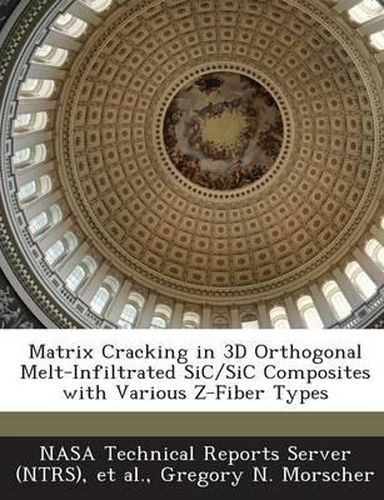Readings Newsletter
Become a Readings Member to make your shopping experience even easier.
Sign in or sign up for free!
You’re not far away from qualifying for FREE standard shipping within Australia
You’ve qualified for FREE standard shipping within Australia
The cart is loading…






The occurrence of matrix cracks in melt-infiltrated SiC/SiC composites with a 3D orthogonal architecture was determined at room temperature for specimens tested in tension oriented in the X-direction (parallel to Z-bundle weave direction) and Y-direction (perpendicular to Z-bundle weave direction) and Y-direction (perpendicular to Z-bundle weave direction). The fiber-types were Sylramic and Sylramic-IBN in the X and Y-directions and lower modulus ZMI, T300, and rayon in the Z-direction. Acoustic emission (AE) was used to monitor the matrix cracking activity. For Y-direction composites, the AE data was used to determine the exact (+/- 0.25 mm) location where matrix cracks occurred in the 3D orthogonal architecture. This enabled the determination of the stress-dependent matrix crack distributions for small but repeatable matrix rich ‘unidirectional’ and the matrix poor ‘cross-ply’ regions within the architecture. It was found that matrix cracking initiated at very low stresses (approx. 40 MPa) in the ‘unidirectional’ regions for the largest z-direction fiber tow composites. Decreasing the size of the z-fiber bundle, increased the stress for matrix cracking in the ‘unidirectional’ regions. Matrix cracking in the ‘cross-ply’ regions always occurred at higher stresses than in ‘unidirectional’ regions, and the stress-dependent matrix crack distribution of the ‘cross-ply’ regions was always over a wider stress-range than the ‘unidirectional’ regions. For composites tested in the X-direction, a lower elastic modulus and a narrower and lower stress-range for matrix cracking were observed compared to composites tested in the Y-direction.
$9.00 standard shipping within Australia
FREE standard shipping within Australia for orders over $100.00
Express & International shipping calculated at checkout
The occurrence of matrix cracks in melt-infiltrated SiC/SiC composites with a 3D orthogonal architecture was determined at room temperature for specimens tested in tension oriented in the X-direction (parallel to Z-bundle weave direction) and Y-direction (perpendicular to Z-bundle weave direction) and Y-direction (perpendicular to Z-bundle weave direction). The fiber-types were Sylramic and Sylramic-IBN in the X and Y-directions and lower modulus ZMI, T300, and rayon in the Z-direction. Acoustic emission (AE) was used to monitor the matrix cracking activity. For Y-direction composites, the AE data was used to determine the exact (+/- 0.25 mm) location where matrix cracks occurred in the 3D orthogonal architecture. This enabled the determination of the stress-dependent matrix crack distributions for small but repeatable matrix rich ‘unidirectional’ and the matrix poor ‘cross-ply’ regions within the architecture. It was found that matrix cracking initiated at very low stresses (approx. 40 MPa) in the ‘unidirectional’ regions for the largest z-direction fiber tow composites. Decreasing the size of the z-fiber bundle, increased the stress for matrix cracking in the ‘unidirectional’ regions. Matrix cracking in the ‘cross-ply’ regions always occurred at higher stresses than in ‘unidirectional’ regions, and the stress-dependent matrix crack distribution of the ‘cross-ply’ regions was always over a wider stress-range than the ‘unidirectional’ regions. For composites tested in the X-direction, a lower elastic modulus and a narrower and lower stress-range for matrix cracking were observed compared to composites tested in the Y-direction.